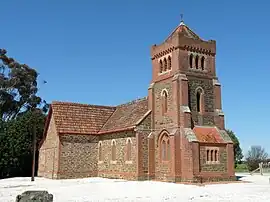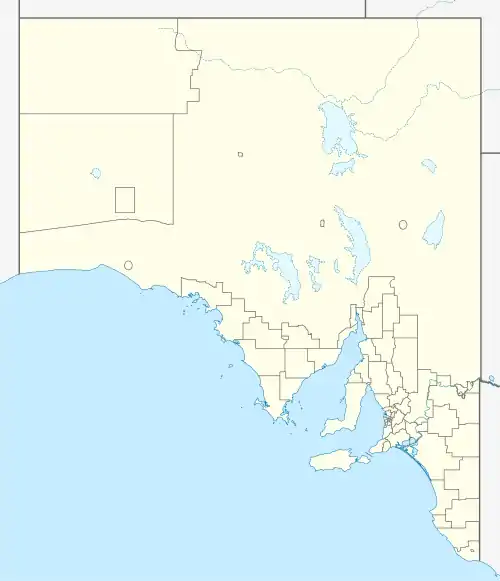Hamilton, South Australia
Hamilton (postcode 5373) is a small township in the Mount Lofty Ranges in South Australia. It is about 120 km northeast of Adelaide, South Australia, about 23 km north of Kapunda. Once a stop for the mining carts going from Adelaide to Burra, but now just a small agricultural district.
| Hamilton South Australia | |||||||||||||||
|---|---|---|---|---|---|---|---|---|---|---|---|---|---|---|---|
 St. Matthew's Anglican Church, Hamilton | |||||||||||||||
 Hamilton | |||||||||||||||
| Coordinates | 34°13′S 138°52′E | ||||||||||||||
| Population | 82 (SAL 2016)[1][2] | ||||||||||||||
| Established | 16 March 2000 (locality)[3] | ||||||||||||||
| Postcode(s) | 5373 | ||||||||||||||
| Time zone | ACST (UTC+9:30) | ||||||||||||||
| • Summer (DST) | ACDT (UTC+10:30) | ||||||||||||||
| Location | |||||||||||||||
| LGA(s) | Light Regional Council | ||||||||||||||
| State electorate(s) | Stuart | ||||||||||||||
| Federal division(s) | Barker | ||||||||||||||
| |||||||||||||||
Hamilton was the birthplace of Albert Percy Blesing in 1879, MP for Northern from 1924 to 1944. He served as Minister for Agriculture, Local Government and Afforestation in the government of Thomas Playford IV. This now shrinking town used to be a very vibrant one with its own football, netball and cricket teams all of which now are non-existent. The Hamilton tennis club is still running and plays in the Julia & Light Tennis Association.[4] The park at Hamilton is called Gill Park and is named after the Gill family which was prominent in the district.[5]
The Hamilton school opened in 1860 by the local residents. The school contributed to the development of the township, as it provided local access to primary education. The nearest town, Kapunda, was too far to travel daily to school with 19th century transport. The Hamilton school closed in 1948 and the remaining students and teacher transferred to Kapunda Primary.[6]
The Dutton Memorial Church of St Matthew was built in 1896 (replacing a more modest building of 1857) and financed by one man, Henry Dutton (1844–1914) of nearby Anlaby Station as a memorial to his brother Frederick, and to Henry's wife Helen and their daughter Ethel, who died accidentally on Granite Island.[7] Henry Dutton was occasional lay reader and, an accomplished musician, played the organ, a magnificent instrument for such a small town. The church is listed on the South Australian Heritage Register.[8]
The historic Anlaby Station complex is located within the modern boundaries of Hamilton. Anlaby Homestead and the Anlaby Shearing Shed, Slaughterhouse, Shearers' Quarters and Manager's House are both separately listed on the South Australian Heritage Register.[9][10]
References
- Australian Bureau of Statistics (27 June 2017). "Hamilton (Suburb and Locality)". Australian Census 2016.
- Australian Bureau of Statistics (27 June 2017). "Hamilton (SA) (Suburb and Locality)". Australian Census 2016 QuickStats. Retrieved 28 June 2022.
- "GEOGRAPHICAL NAMES ACT 1991, Notice to Assign Names and Boundaries to Places (within the District Council of Kapunda and Light )" (PDF). The South Australian Government Gazette. South Australian Government. 16 March 2000. p. 1433. Retrieved 6 March 2018.
- "Julia and Light Tennis Association". Eudunda.net. 10 January 2015. Retrieved 16 March 2015.
- "The Country". Daily Herald. Adelaide. 22 June 1910. p. 6. Retrieved 10 August 2015 – via National Library of Australia.
- "The Hamilton school". Retrieved 11 May 2015.
- "St. Matthews Anglican Church, Hamilton, South Australia". Organ Historical Trust of Australia. Retrieved 28 November 2015.
- "Dutton Memorial Church of St Matthew (Anglican)". South Australian Heritage Register. Department of Environment, Water and Natural Resources. Retrieved 4 May 2016.
- "Anlaby Homestead (including main & bluestone dwellings, stables, grotto, courtyard & quarters)". South Australian Heritage Register. Department of Environment, Water and Natural Resources. Retrieved 4 May 2016.
- "Anlaby Shearing Shed, Slaughterhouse, Shearers' Quarters and Manager's House". South Australian Heritage Register. Department of Environment, Water and Natural Resources. Retrieved 4 May 2016.